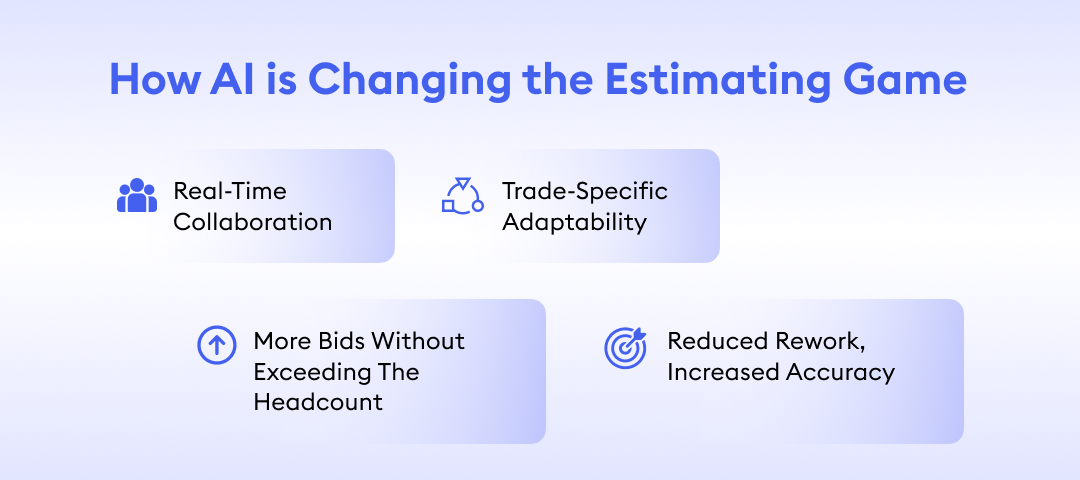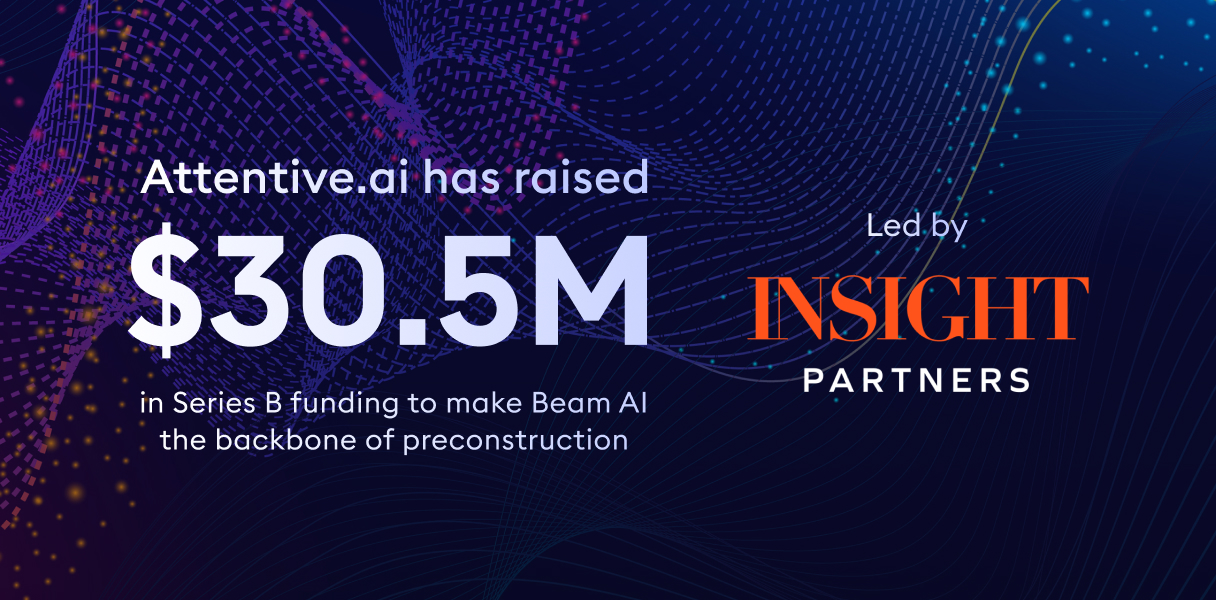It’s Monday morning, the bid board has five new ITBs staring back at you, and the plan-PDF stack on the desk is already taller than you’d hoped. You download dozens of drawings, open architectural, structural, and MEP sheets. You scope them: what trades do you cover, what to exclude, what addendum is there that dropped late Friday, and so on. Then you start the material takeoff: Your team spends hours, and all the while, the bid deadline is looming.
On Reddit’s r/estimators, one user summed it up perfectly:
Manual takeoffs don’t just consume time-they drain the estimator’s capacity to pursue & vet more bid opportunities. Every 20 hours spent on doing takeoff means one less bid submitted, one more night spent verifying quantities, and one more risk of human error sneaking into the estimate.
Not to mention, the window of time you could have spent on pre-bid site walks & speaking with suppliers is now closing.
Where Does the Estimating Time Really Go
According to a report by Autodesk, preconstruction professionals spend an average of 13.4 hours per week just on researching and analysing estimating data — and that’s even before price work begins. Those hours don’t include scoping, pricing, or RFI responses.
Here’s what really consumes the week:
- Downloading and organizing plan sets from multiple bid portals
- Organizing ITBs and deciding bid/no-bid
- Double-checking legends and notes to ensure correct material quantities
- Re-doing takeoffs every time an addendum drops two days before submission
Each task eats up valuable bandwidth that could instead go toward pricing strategy, subcontractor coordination, or expanding your opportunity pipeline.
These repetitive steps eat up capacity. Even if you’re fast, addenda can derail progress instantly. As one estimator vented on Reddit:
Every correction, every recount, every misaligned legend leads to rework, and that’s where AI takeoff software has the biggest impact.
How AI Changes the Estimating Game

1. More bids without exceeding the headcount
AI takeoff software helps you complete takeoffs up to 90% faster, which means you can double your bid volume in the same quarter without hiring additional estimators.
Get 15–20 hours back per week with Beam AI, which can be reallocated to pricing strategy, client coordination, or pre-bid reviews—high-value work that actually wins jobs.
2. Reduced rework, increased accuracy
AI software doesn’t fatigue or miss small legends. You basically have a software fully scanning through 100s of sheets to factor in all notes & specs that are mentioned on the site plan to perform a takeoff.
And because AI systems cross-reference data between plan sheets, they instantly flag discrepancies when addenda arrive. No more starting from scratch on version six of a drawing set.
Read about the plan discrepancy callout feature
3. Real-time collaboration
Modern takeoff tools are cloud-based, allowing estimators and project managers to access the same data in real time. You can track changes, leave comments, and review revisions without emailing five different Excel files.
It’s a collaborative shift that eliminates version conflicts and creates a single source of truth throughout the preconstruction process.
4. Trade-specific adaptability
AI estimating tools are not one-size-fits-all. They adapt to how you measure:
- HVAC/Mechanical contractors may focus on air ducts, flex duct takeoffs, pipes, and fittings.
- Steel suppliers may focus on beam layouts, angles, channels, and connections.
- Concrete or masonry teams measure cubic volumes and rebar tonnage.
Why This Shift Is Happening Now
As project pipelines grow, deadlines shrink. The same estimating teams are expected to handle twice the bid volume with no extra headcount.
Manual takeoffs just can’t keep up — not because estimators aren’t efficient, but because the workflow itself is broken. When your productivity depends on clicking, counting, and measuring, you’re working in inches while your competitors are bidding in miles. AI takeoff software flips that equation.
Addressing Common Concerns About AI Takeoff Tools
It’s normal to wonder whether artificial intelligence will disrupt your current estimating process. But Beam AI takeoff software doesn’t replace the estimator—it amplifies their output.
Here’s how it fits naturally into your workflow:
- Less Manual Work, More Decision-Making:
Beam AI automates measuring and categorizing materials quantities so you can focus on pricing strategy and bid competitiveness. - Fewer Surprises Mid-Bid:
When addenda or revisions arrive, Beam AI automatically detects plan changes and redoes your entire takeoff. No manual rework, no missed updates. - No Workflow Disruption:
Beam AI easily integrates with your existing estimating software. You also get downloadable PDFs and a shareable takeoff link—making it easy to include in your bid package or send to your project team for instant review.
Who Needs AI Takeoff Software? Use Cases Across Trades
From chasing material quantities to sending them out for supplier quotes and then leveling bids between subs and GCs, every role in preconstruction faces the same bottleneck: time.
Here’s how AI takeoff software reshapes that reality across trades and roles.
1. General Contractors (GCs)
You’re running multiple bids simultaneously, coordinating subcontractors, and tracking deadlines that all seem to hit on the same Friday. Each project comes with dozens of plan sheets, hundreds of revisions, and multiple trades to manage. One missed update in a drawing or a scope gap from a sub can derail the entire estimate — and since the final accountability of the bid ultimately lands on your desk, every detail matters.
Beam AI provides version control and addendum variance reporting functionalities—so if a plan revision lands mid-bid, the software detects changes and updates quantities accordingly, rather than forcing a full redo.
What this means for you is tangible: instead of spending 15-20 hours revalidating material quantities per project, your estimating team can spend that time on bid strategy, subcontractor review, value engineering, and pipeline growth.
2. Subcontractors
You specialize in one trade: HVAC, concrete, drywall, or electrical, but every week feels like a battle with PDFs. You’re opening 40+ plan sheets, zooming in on every note and detail, and hoping no addenda drop before submission.
By automating repetitive manual measurement and scope verification using AI takeoff software such as Beam AI, subcontractors can increase monthly bid capacity by up to 2× without expanding headcount.
With faster bid cycles, your odds of being the first to reach your GC with a competitive bid increase - ultimately improving your winning chances.
One of Beam AI’s leading customers, Axion Specialty Contracting, saved 2 days on doing takeoffs while improving project management bandwidth. This actually translates to more opportunities in your pipeline and better odds of winning profitable work.
3. Estimators and Estimating Firms
Whether you work in-house or run an estimating service, you’re under pressure to deliver precise numbers on impossible timelines. One project might demand an HVAC takeoff; the next, a multi-trade quantity package for a commercial build. Most firms still rely on manual measurement workflows in Bluebeam or Excel, which makes consistency a daily challenge.
AI-based takeoffs allow you to take on more bids per month, maintain consistency across deliverables, and allocate your bandwidth to higher-value activities like client interaction, risk assessment, and pricing optimization.
With Beam AI’s automated takeoff workflow, you can upload project PDFs and receive QA-reviewed, estimate-ready trade-specific material quantities, accurate to ±1% of your in-house standard. For typical-sized projects, outputs are delivered in 24-72 hours.
Explore the Bluebeam vs Beam AI comparison guide
4. Suppliers
Suppliers depend on contractors’ takeoffs for forecasting materials, managing inventory, and aligning delivery schedules. But when material quantities are inconsistent across multiple bids or plan sets, your procurement and supply chain decisions become guesswork.
Late takeoffs or inaccurate quantities lead to overstocking or shortages, disrupting both pricing and delivery. Suppliers often have to revalidate quantities themselves just to ensure alignment with contractors — wasting valuable time.
AI-based material quantity takeoff software, such as Beam AI, ensures consistent and transparent takeoff outputs across all trades. By reading specifications and structural notes directly, it delivers standardized quantity breakdowns that suppliers can trust.
Final thought
AI takeoff software isn’t just another tool; it’s the next evolution of how preconstruction teams compete. It helps you:
- Expand your monthly bid capacity
- Free up time for strategy, pricing, and client coordination
- Keep bids accurate and consistent, even under a tight deadline
- Save 90% time on doing takeoffs
If your team is still spending more time measuring than managing, it’s time to see what Beam AI can do for your estimating workflow.



.png)






.png)
.png)
.png)

.webp)

